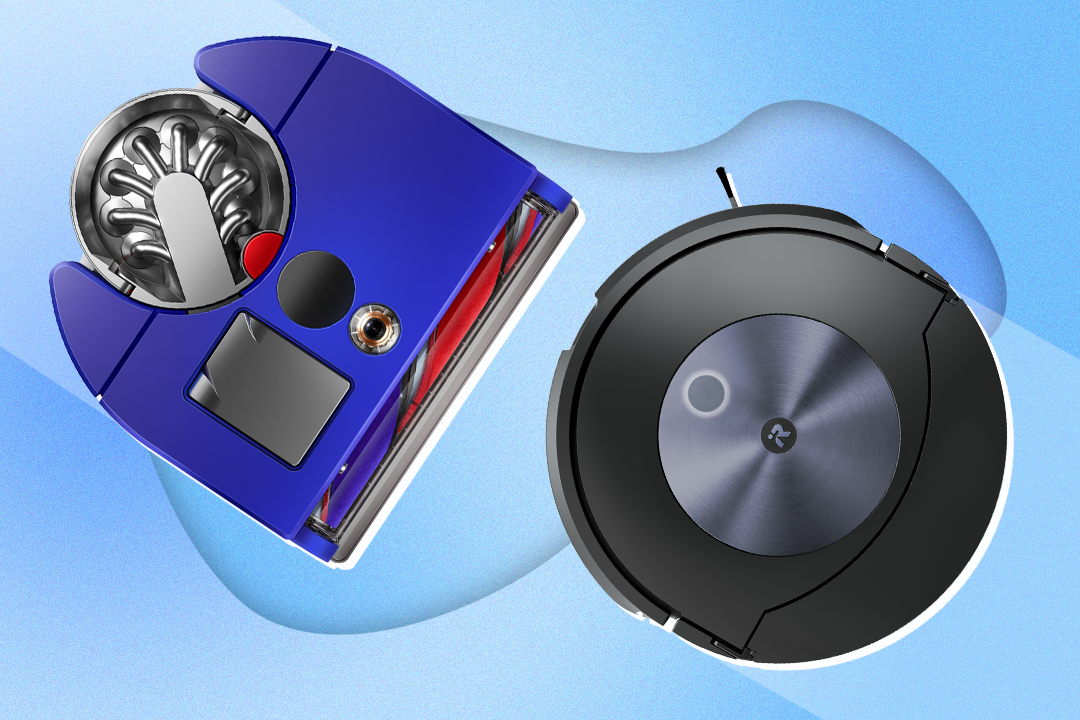The Independent's journalism is supported by our readers. When you purchase through links on our site, we may earn commission. Why trust us?
Dyson 360 Vis Nav vs iRobot roomba combo j7+: Which robot vacuum cleaner should you buy?
We put these mean cleaning machines head to head

iRobot has been the leading name in robot vacuum cleaners for over a decade. The first commercially successful robot vacuum cleaner was relatively primitive by today’s standards, dumbly bouncing between walls and sucking up whatever it happened to trundle across, but later generations introduced intelligent navigation, floor mapping, self-emptying bins, obstacle avoidance and mopping modes.
While iRobot’s roomba is synonymous with robovacs, a raft of competitors soon entered the market, including Dyson. The electronics brand is best known for its cutting-edge cordless vacuum cleaners, bladeless desk fans, stylish hair straighteners and high-speed hand dryers. If it sucks or blows, Dyson is generally on top of it.
After a few failed attempts, Dyson’s first commercially available robot vacuum cleaner was the 360 eye. Too bulky to be very practical, the 360 eye at least illustrated the brand’s original approach to designing a non-human-operated vacuum cleaner. Rather than seeing how much vacuum suction they could cram into a robot, Dyson started with a full-sized, fully powered vacuum and tried to shrink it down to Roomba size.
Dyson’s latest robot vacuum is the company’s best model yet. The 360 vis nav is a D-shaped vacuum cleaner that’s short enough to fit under furniture and get into corners. According to Dyson, it’s the most powerful robot vacuum cleaner in the world, and whereas previous models weren’t very intelligent, the 360 vis nav uses a fisheye camera to create maps of your home, avoid obstacles and clean more efficiently.
So how does the Dyson 360 vis nav compare to our pick of the best robot vacuum cleaners in 2024, the iRobot roomba combo j7+?
How we tested the Dyson 360 vis nav and iRobot roomba combo j7+
Testing took place in our writers’ homes, not in laboratory-style test scenarios, so we can see how these devices perform in the real world. The iRobot roomba combo j7+ has been our leading favourite since our full roomba j7+ review, so we treated the Dyson 360 vis nav to the same conditions as the leading model.
Both robot vacuums operated in a two-bedroom flat with no stairs and a small dog. The flat is a mix of hardwood and carpeted flooring. We also subjected the robot vacuum cleaners to different challenges by dropping flour, dry lentils and dog food in their path to see how each model coped with the mess.
We also paid close attention to ease of use, app functionality and battery life. Keep reading to see how both models compared.
Design
The Dyson 360 vis nav (£1,199.99, Currys.co.uk) comes in a shocking shade of blueish purple, and it looks utterly unlike any other robot vacuum cleaner on the market. It adopts most of the same design cues as the brand’s other product ranges, blending bold colours and metallic highlights with industrial detailing. You’ll either love it or hate it.
The roomba combo j7+ (£729, Amazon.co.uk) comes in a more muted style. The black plastic chassis of the robot is designed to blend into the home more readily, while the size and shape of the self-emptying bin, with its neat leather opening tab, wouldn’t look out of place in any corner of the house. We commend Dyson’s daring design choices here, but for most shoppers, the plainer roomba will be more appealing.
Cleaning
Dyson proudly claims that its robot vacuum cleaner is six times more powerful than any other on the market. In our tests, this seems to hold true. Not only is the 360 vis nav adept at picking up way more dirt and dust in a single pass, but it uses a unique extending arm to get right into corners too, something no other robovac we’ve tested can manage. A special boost mode unlocks the full suction power of the device but cuts the battery life down to just 12 minutes. That’s not an issue if you’re out of the house all day – the robot can return to its base as many times as it needs to recharge – but seems unnecessarily powerful when a series of several longer, gentler passes would achieve the same result.
Read more: The best corded vacuum cleaners in 2024
iRobot’s roomba combo j7+ is a less powerful vacuum cleaner, though it can effectively achieve the same results as the Dyson simply by taking multiple passes, even if it takes more time. It’s a round-bodied robot, meaning it’s worse at reaching into corners but better at navigating tight spaces. While it doesn’t have an extending arm, the rotating brush does a decent job of sweeping up dust and dirt from around the edges of the room.
In terms of raw suction power, the crown goes to Dyson. But suction isn’t everything when it comes to robot vacuum cleaners – given enough time the roomba will tidy just as well.
More importantly, the roomba combo j7+ has more features. There’s a mopping arm which automatically deploys or retracts when the robot moves between a hard floor and a carpeted surface. It also comes with a self-emptying bin, which can hold a few weeks’ worth of dirt and dust before it needs manual emptying.
Navigation
iRobot has years of experience in designing robovacs that can identify and navigate around common household obstacles. The roomba combo j7+ uses its on-board camera to spot and avoid hazards like cables, shoelaces, pet mess and socks – all things that can easily get tangled around the robot’s brush.
At the end of a run, the robot will send you a summary of the things that startled it, so you can tidy the obstacles away or reassure it that the object wasn’t something it needed to avoid. Over time it learns which household items to avoid, meaning you can confidently let the robot work while you’re away from home without worrying about coming home to a disaster scene.
Read more: How IndyBest tests cordless vacuum cleaners
Dyson lags far behind iRobot in this arena. The 360 vis nav has an on-board camera, which it uses to help it figure out where it is in the home, but its rudimentary obstacle detection means it will readily get tangled in any loose charging cables, dangling shoelaces or trailing blind cords. Before sending it off on a cleaning run you’ll need to tidy away anything that could potentially get snarled up in its rotating brush, making the 360 vis nav way less useful in busy, messy homes.
The verdict: Dyson 360 vis nav vs iRobot roomba combo j7+
Dyson’s latest robot vacuum cleaner is a powerful appliance, but the brand struggles to compete with iRobot on the basic features that truly matter in a robot vacuum cleaner. The roomba combo j7+ can mop as well as vacuum, empty its own bin and deftly navigate around everyday hazards that would trip up the 360 vis nav.
More importantly, the roomba roundly beats the 360 vis nav on price, costing almost half as much as Dyson’s robovac. Dyson will always be a prestige brand with a price to match, but whereas its full-size vacuums are among the very best you can buy, when it comes to robot vacuum cleaners Dyson is way behind the competition.
Interested to see the competition? Read our review of the best robot vacuum cleaners
Subscribe to Independent Premium to bookmark this article
Want to bookmark your favourite articles and stories to read or reference later? Start your Independent Premium subscription today.
